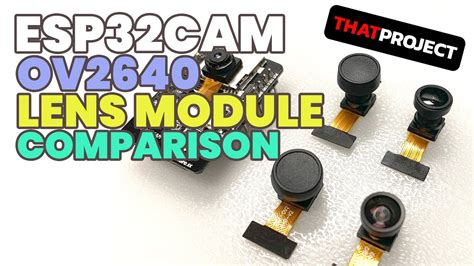Introduction to OV2640
The OV2640 is a popular image sensor widely used in various applications, including IoT devices, security cameras, and embedded systems. Developed by OmniVision Technologies, this compact and versatile sensor offers high-quality image capture capabilities at an affordable price point. In this comprehensive guide, we will delve into the features, specifications, and applications of the OV2640, providing you with all the information you need to effectively utilize this powerful image sensor in your projects.
Key Features of the OV2640
High-Resolution Image Capture
The OV2640 boasts a maximum resolution of 1600 x 1200 pixels (2 megapixels), enabling it to capture detailed and crisp images. This resolution is suitable for a wide range of applications, from surveillance systems to digital signage and more.
Compact Form Factor
Measuring just 6.5 x 6.5 x 4.5 mm, the OV2640 is incredibly compact, making it ideal for integration into space-constrained devices. Its small size allows for easy integration into various systems without compromising on image quality.
Low Power Consumption
One of the standout features of the OV2640 is its low power consumption. With a typical power consumption of just 140 mW, this sensor is well-suited for battery-powered devices and energy-efficient applications.
Flexible Interface Options
The OV2640 supports multiple interface options, including:
– 8-bit parallel interface
– 10-bit parallel interface
– SCCB (Serial Camera Control Bus)
– I2C interface
This flexibility enables easy integration with a wide range of microcontrollers and embedded systems.
OV2640 Specifications
| Parameter | Value |
|---|---|
| Active Array Size | 1600 x 1200 |
| Pixel Size | 2.8 µm x 2.8 µm |
| Image Area | 4480 µm x 3360 µm |
| Package Dimensions | 6.5 mm x 6.5 mm x 4.5 mm |
| Chief Ray Angle | 27.3° (diagonal) |
| Sensitivity | 600 mV/lux-sec |
| Dynamic Range | 69 dB |
| SNR | 40 dB |
| Max Frame Rate | 15 fps @ 1600×1200, 30 fps @ 800×600 |
| Operating Temperature | -30°C to +70°C |
| Power Supply | 1.8V / 2.8V |
| Power Consumption | 140 mW (typical) |

Interfacing with the OV2640
Hardware Connections
To interface with the OV2640, you’ll need to establish the following hardware connections:
– Power supply: Connect the sensor’s VDD and GND pins to the appropriate power supply (1.8V or 2.8V).
– Clock input: Provide a clock signal to the XCLK pin for proper timing.
– I2C or SCCB interface: Connect the SDA and SCL pins for configuration and control.
– Parallel interface: Connect the data lines (D0-D7 or D0-D9) and control signals (VSYNC, HREF, PCLK) for image data output.
Software Configuration
To configure and control the OV2640, you’ll need to use the appropriate software libraries and drivers specific to your development platform. Some popular platforms and libraries include:
– Arduino: ArduCAM library
– Raspberry Pi: PiCamera library
– STM32: STM32Cube library
– ESP32: ESP32-Camera library
These libraries provide functions and APIs to initialize the sensor, set resolution, adjust exposure and gain, and capture images.
Applications of the OV2640
Security and Surveillance
The OV2640’s high-resolution imaging capabilities make it well-suited for security and surveillance applications. It can be integrated into IP cameras, doorbell cameras, and other monitoring systems to capture clear and detailed images.
IoT Devices
With its low power consumption and compact size, the OV2640 is an excellent choice for IoT devices that require image capture functionality. It can be used in smart home devices, wearables, and industrial sensors to enable visual data acquisition.
Robotics and Drones
The OV2640 finds applications in robotics and drones, where it can be used for object detection, navigation, and visual feedback. Its small form factor and low power requirements make it ideal for integration into these mobile systems.
Automotive
In the automotive industry, the OV2640 can be used for various purposes, such as backup cameras, driver monitoring systems, and advanced driver assistance systems (ADAS). Its reliable performance and compact size make it suitable for these demanding applications.
Frequently Asked Questions (FAQ)
1. What is the maximum resolution supported by the OV2640?
The OV2640 supports a maximum resolution of 1600 x 1200 pixels (2 megapixels).
2. Can the OV2640 be used with Arduino boards?
Yes, the OV2640 can be interfaced with Arduino boards using the ArduCAM library, which provides functions to initialize and control the sensor.
3. What is the typical power consumption of the OV2640?
The typical power consumption of the OV2640 is 140 mW, making it suitable for low-power applications.
4. Does the OV2640 support both parallel and serial interfaces?
Yes, the OV2640 supports both parallel (8-bit and 10-bit) and serial (SCCB and I2C) interfaces, providing flexibility in integration with different systems.
5. Is the OV2640 suitable for outdoor applications?
The OV2640 has an operating temperature range of -30°C to +70°C, making it suitable for both indoor and outdoor applications. However, proper enclosure and protection against environmental factors should be considered for outdoor use.
Conclusion
The OV2640 is a versatile and powerful image sensor that offers high-resolution imaging, low power consumption, and a compact form factor. Its flexibility in interfacing options and wide range of applications make it a popular choice for developers and engineers working on projects that require image capture capabilities.
By understanding the features, specifications, and interfacing requirements of the OV2640, you can effectively integrate this sensor into your designs and unlock its full potential. Whether you’re building a security system, IoT device, or automotive application, the OV2640 provides a reliable and cost-effective solution for high-quality image capture.

No responses yet